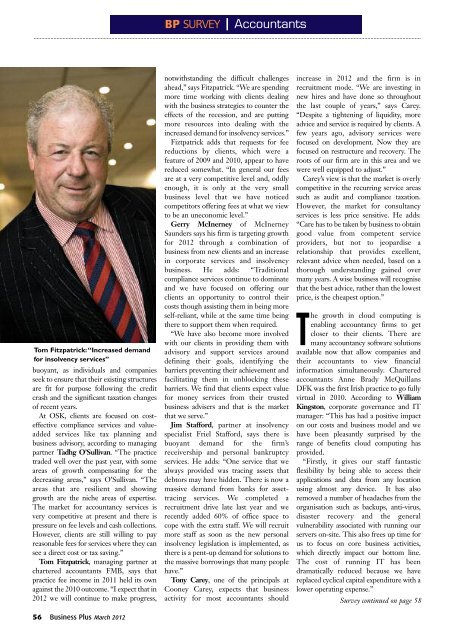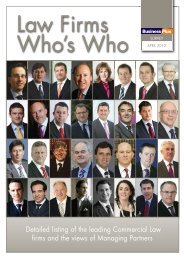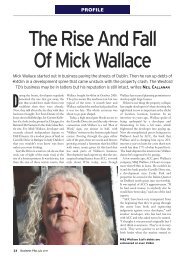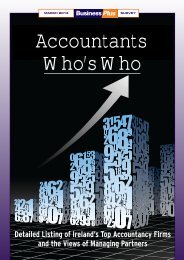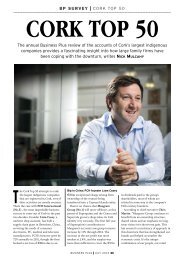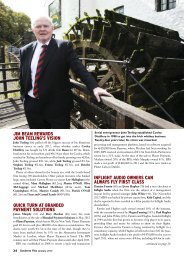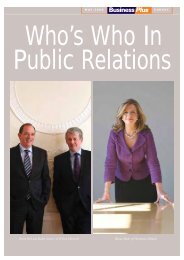Download - Business Plus Online
Download - Business Plus Online
Download - Business Plus Online
Create successful ePaper yourself
Turn your PDF publications into a flip-book with our unique Google optimized e-Paper software.
Tom Fitzpatrick:“Increased demand<br />
for insolvency services”<br />
buoyant, as individuals and companies<br />
seek to ensure that their existing structures<br />
are fit for purpose following the credit<br />
crash and the significant taxation changes<br />
of recent years.<br />
At OSK, clients are focused on costeffective<br />
compliance services and valueadded<br />
services like tax planning and<br />
business advisory, according to managing<br />
partner Tadhg O’Sullivan. “The practice<br />
traded well over the past year, with some<br />
areas of growth compensating for the<br />
decreasing areas,” says O’Sullivan. “The<br />
areas that are resilient and showing<br />
growth are the niche areas of expertise.<br />
The market for accountancy services is<br />
very competitive at present and there is<br />
pressure on fee levels and cash collections.<br />
However, clients are still willing to pay<br />
reasonable fees for services where they can<br />
see a direct cost or tax saving.”<br />
Tom Fitzpatrick, managing partner at<br />
chartered accountants FMB, says that<br />
practice fee income in 2011 held its own<br />
against the 2010 outcome. “I expect that in<br />
2012 we will continue to make progress,<br />
56 <strong>Business</strong> <strong>Plus</strong> March 2012<br />
notwithstanding the difficult challenges<br />
ahead,” says Fitzpatrick. “We are spending<br />
more time working with clients dealing<br />
with the business strategies to counter the<br />
effects of the recession, and are putting<br />
more resources into dealing with the<br />
increased demand for insolvency services.”<br />
Fiztpatrick adds that requests for fee<br />
reductions by clients, which were a<br />
feature of 2009 and 2010, appear to have<br />
reduced somewhat. “In general our fees<br />
are at a very competitive level and, oddly<br />
enough, it is only at the very small<br />
business level that we have noticed<br />
competitors offering fees at what we view<br />
to be an uneconomic level.”<br />
Gerry McInerney of McInerney<br />
Saunders says his firm is targeting growth<br />
for 2012 through a combination of<br />
business from new clients and an increase<br />
in corporate services and insolvency<br />
business. He adds: “Traditional<br />
compliance services continue to dominate<br />
and we have focused on offering our<br />
clients an opportunity to control their<br />
costs though assisting them in being more<br />
self-reliant, while at the same time being<br />
there to support them when required.<br />
“We have also become more involved<br />
with our clients in providing them with<br />
advisory and support services around<br />
defining their goals, identifying the<br />
barriers preventing their achievement and<br />
facilitating them in unblocking these<br />
barriers. We find that clients expect value<br />
for money services from their trusted<br />
business advisers and that is the market<br />
that we serve.”<br />
Jim Stafford, partner at insolvency<br />
specialist Friel Stafford, says there is<br />
buoyant demand for the firm’s<br />
receivership and personal bankruptcy<br />
services. He adds: “One service that we<br />
always provided was tracing assets that<br />
debtors may have hidden. There is now a<br />
massive demand from banks for assettracing<br />
services. We completed a<br />
recruitment drive late last year and we<br />
recently added 60% of office space to<br />
cope with the extra staff. We will recruit<br />
more staff as soon as the new personal<br />
insolvency legislation is implemented, as<br />
there is a pent-up demand for solutions to<br />
the massive borrowings that many people<br />
have.”<br />
Tony Carey, one of the principals at<br />
Cooney Carey, expects that business<br />
activity for most accountants should<br />
increase in 2012 and the firm is in<br />
recruitment mode. “We are investing in<br />
new hires and have done so throughout<br />
the last couple of years,” says Carey.<br />
“Despite a tightening of liquidity, more<br />
advice and service is required by clients. A<br />
few years ago, advisory services were<br />
focused on development. Now they are<br />
focused on restructure and recovery. The<br />
roots of our firm are in this area and we<br />
were well equipped to adjust.”<br />
Carey’s view is that the market is overly<br />
competitive in the recurring service areas<br />
such as audit and compliance taxation.<br />
However, the market for consultancy<br />
services is less price sensitive. He adds:<br />
“Care has to be taken by business to obtain<br />
good value from competent service<br />
providers, but not to jeopardise a<br />
relationship that provides excellent,<br />
relevant advice when needed, based on a<br />
thorough understanding gained over<br />
many years. A wise business will recognise<br />
that the best advice, rather than the lowest<br />
price, is the cheapest option.”<br />
The growth in cloud computing is<br />
enabling accountancy firms to get<br />
closer to their clients. There are<br />
many accountancy software solutions<br />
available now that allow companies and<br />
their accountants to view financial<br />
information simultaneously. Chartered<br />
accountants Anne Brady McQuillans<br />
DFK was the first Irish practice to go fully<br />
virtual in 2010. According to William<br />
Kingston, corporate governance and IT<br />
manager: “This has had a positive impact<br />
on our costs and business model and we<br />
have been pleasantly surprised by the<br />
range of benefits cloud computing has<br />
provided.<br />
“Firstly, it gives our staff fantastic<br />
flexibility by being able to access their<br />
applications and data from any location<br />
using almost any device. It has also<br />
removed a number of headaches from the<br />
organisation such as backups, anti-virus,<br />
disaster recovery and the general<br />
vulnerability associated with running our<br />
servers on-site. This also frees up time for<br />
us to focus on core business activities,<br />
which directly impact our bottom line.<br />
The cost of running IT has been<br />
dramatically reduced because we have<br />
replaced cyclical capital expenditure with a<br />
lower operating expense.”<br />
Survey continued on page 58


